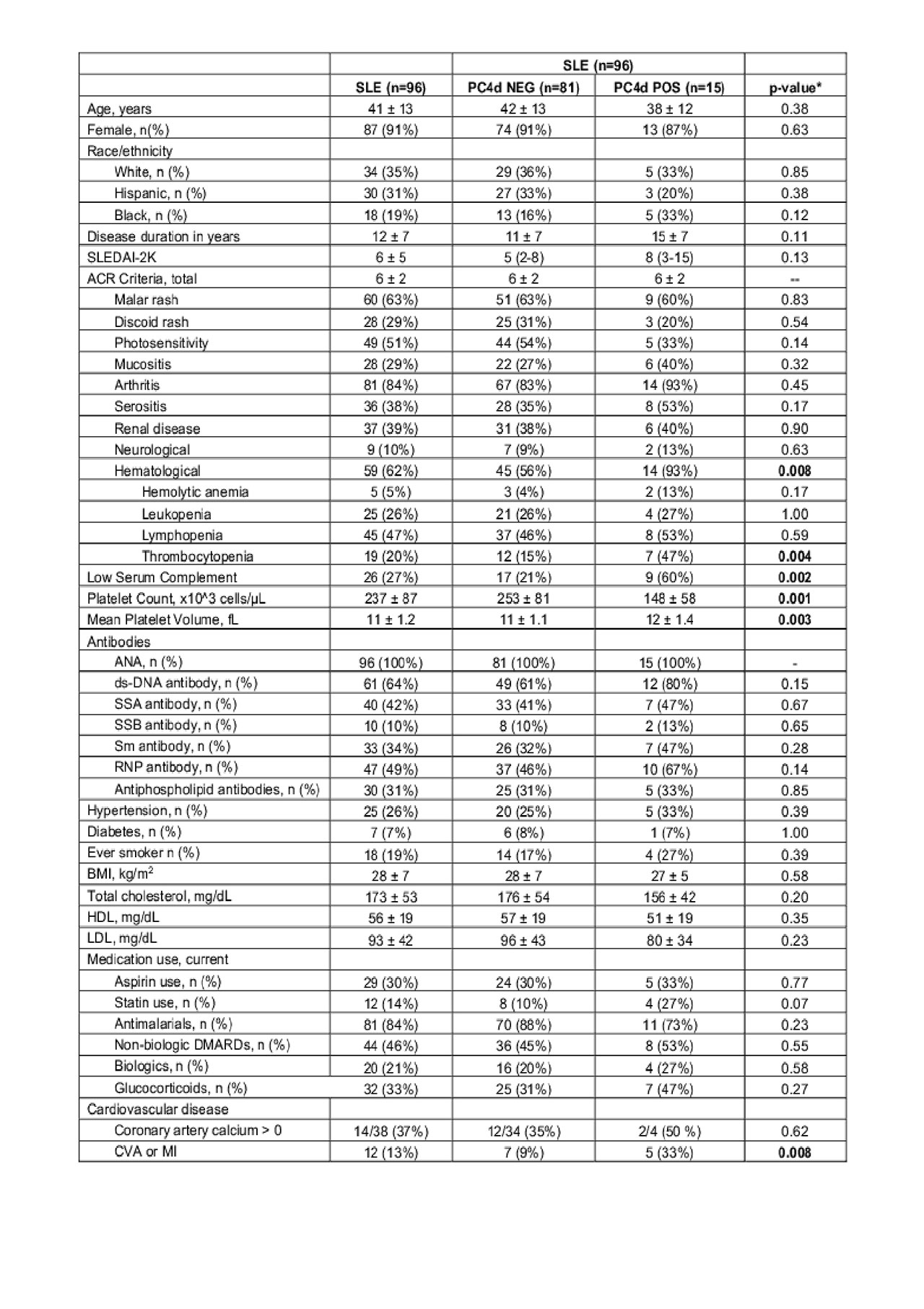Session Information
Session Type: Poster Session (Monday)
Session Time: 9:00AM-11:00AM
Background/Purpose: Cell-bound complement activation products (CB-CAPs), including platelet bound C4d (PC4d), are sensitive markers for diagnosis and evaluation of lupus activity. Presence of PC4d is associated with antiphospholipid antibodies and thrombotic events in SLE, but its role in cardiovascular (CV) disease is not fully understood. The current study investigates if PC4d is a biomarker for CV disease in SLE.
Methods: In a cohort of 96 SLE patients, we evaluated the association between PC4d and clinical and subclinical cardiovascular (CV) disease, defined by CV events and/or presence of coronary artery calcium (CAC), respectively. Blood was collected and PC4d levels, measured by flow cytometry, were reported as positive or negative, defined by a cutoff of 20 mean fluorescence intensity (MFI). CV events were defined as any medical record documentation or self-report of a myocardial infarction or ischemic cerebrovascular accident. Non-contrast CT chest, performed when required for routine clinical care, was used for calculating CAC scores. Demographics, disease characteristics, and cardiovascular comorbidities were ascertained. Disease activity was assessed using SLE Disease Activity Index 2000 (SLEDAI-2K).
Results: 96 SLE patients were included (41±13 years old, 91% female, 35% Caucasian, 31% Hispanic, 19% African American, disease duration 12±7 years). SLE patients met on average 6±2 ACR-SLE classification criteria. All were ANA+, 64% were dsDNA+, 31% antiphospholipid (aPL) antibodies positive. Average SLE disease activity was 6±5, 39% had lupus nephritis. CV comorbidities included: 19% had a history of smoking, 26% had hypertension, 7% were diabetic and 8% had hyperlipidemia. Average total cholesterol level was 173±53 mg/dL. A positive PC4d level was detected in 16% (n=15). 13% (n=12) had a history of a CV event while CAC >0 was detected in 37% of the 38 patients with available scores. There was no association between history of CV event and presence of CAC >0 (p=0.62). PC4d was associated with history of a CV event (OR 5.3 95% CI 1.4-19.9 p=0.008) but not with the presence of CAC >0 (35% vs 50%, p=0.62). Additionally, positive PC4d was associated with low complement levels (60% vs 21%, p=0.001), history of thrombocytopenia by ACR criteria (47% vs 15%, p=0.004), a lower platelet count (253±81 vs. 148±58 x cells/µL, p=0.0001) and a larger platelet volume (11±1.1 vs 12±1.4fL p=0.003) at the time of PC4d measurement. In a multivariable model, the association between CV events and PC4d, as well as between platelet count/volume and PC4d, remained significant and independent of aPL status or low complement.
Conclusion: In this pilot study, the presence PC4d was associated with history of CV events, lower platelet counts, and larger mean platelet volumes, suggesting that PC4d may be a marker for complement-mediated platelet activation and morphological change, as well as arterial thrombotic events in SLE. No association was found between PC4d and subclinical atherosclerosis or CV events and subclinical atherosclerosis, further supporting that CV events in SLE are not entirely mediated through traditional CV risk factors.
To cite this abstract in AMA style:
Gartshteyn Y, Mor A, Geraldino L, Kapoor T, Chen T, Dervieux T, Askanase A. Platelet Bound Complement Split Product (PC4d) May Be a Marker of Platelet Activation and Cardiovascular Events in Systemic Lupus Erythematosus [abstract]. Arthritis Rheumatol. 2019; 71 (suppl 10). https://acrabstracts.org/abstract/platelet-bound-complement-split-product-pc4d-may-be-a-marker-of-platelet-activation-and-cardiovascular-events-in-systemic-lupus-erythematosus/. Accessed .« Back to 2019 ACR/ARP Annual Meeting
ACR Meeting Abstracts - https://acrabstracts.org/abstract/platelet-bound-complement-split-product-pc4d-may-be-a-marker-of-platelet-activation-and-cardiovascular-events-in-systemic-lupus-erythematosus/

